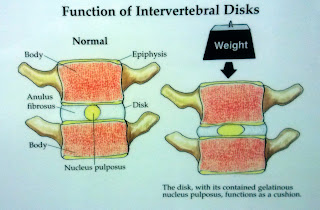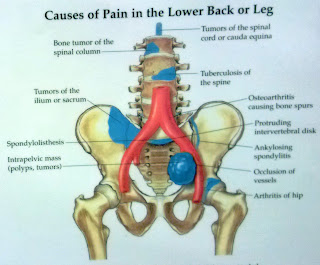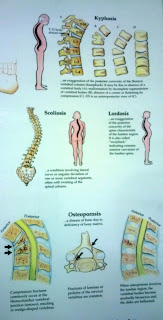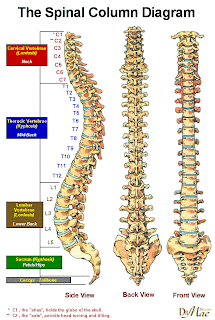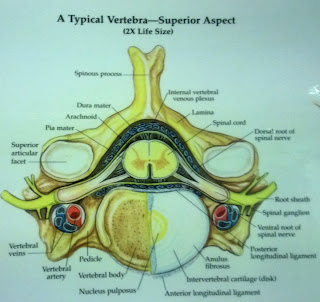A simple description of HNP copied from www.laserspineinstitute.com
HNP, or a herniated nucleus pulposus, is the more medically oriented term for what most people refer to as a “herniated disc.” The nucleus pulposus is the gel-like inner material found within the thick, outer wall of each intervertebral disc, which are soft, sponge-like bodies responsible for providing support and flexibility along the entire length of the spine.

Due to the gradual deterioration of these discs over time as part of the natural aging process, these discs develop a tear and the nucleus pulposus can push through the disc wall and extrude into the spinal canal – a condition known as a herniated nucleus pulposus
In Indonesia, HNP can be called as "Saraf Kejepit" which literally means nerve compression. Unfortunatelly this term has been used so commonly for all nerve compression problem such that it is difficult to distinguish HNP with other causes of nerve compression.
Albeit the similar symptomps of all nerve compression problem, I have to strongly emphasize that you need to identify a specific cause to your nerve compression issue, HNP being one of them.
To understand this better, let's take a look at how the intevertebral disk works. See the illustration in the picture below
As can be seen, the nucleus pulpolus will expand as the spine takes on weight. The more weight it takes, the more flattened it gets. If you combines heavy weight with akward position, it can cause the flattened disk to comes (herniates) out from the disk, and pinches to your nerve. This is what it means by HNP.
However, in more often circumstances, it may be only the Annulus Fibrosus and not the Nucleous Pulposus that is out of its place. In this case, you will get a bulging disk, that may pinch to your nerve, but it is not in any case a HNP. A bulging disk is said to be easier to fix, requiring mainly physical exercise, physiotherapist and acupunture as the options to get it back to its place. There is a reference that quote that most of the cases for this will heal by itself in 6 - 8 weeks.
Common Symptomps
Herniated disc can occur at any intervertebral disc along your spine, as such, the symptopms will be pretty much dependent on where it takes place. However, these are the list of the general common symptopms of HNP:
- Neck Pain
- Arm Pain
- Numbness, weakness or Tingling Sensation (on leg, arm, foot or palm)
- Lower Back Pain or Pain in the buttock
- Sciatica
- Loss of bladder or bowel control (rare, severe case)
Sciatica is the term often used to describe the pain going down the leg, up to the foot. Specific symptopms varies for each case. Some will feel the pain while sitting, and will disappear while standing, whereas the others could have it the other way around, painful while walking and disappear while sitting.
For a more detailed explanation for sciatica, i can quote a few good references as follow:
http://www.spine-health.com/conditions/sciatica/what-you-need-know-about-sciatica
http://en.wikipedia.org/wiki/Sciatica
http://www.nlm.nih.gov/medlineplus/sciatica.html
Other Nerve Compression Problems
As emphasized earlier that it is dully important to identify a specific condition for a general nerve compression symptomps. Before arriving at the conclusion of a person suffering HNP, one must carefully examine if the symptomps are a better fit for the other conditions.
There are a few other conditions which have a very similar symptomps with HNP but have a totally different treatment. For instance, spinal stenosis, degenerative disc disease and scoliosis.
A few main problems are illustrated in the pictures below
A brief descriptions for almost all conditions related to spine problem is provided below (Ref. www.spine-health.com)
Topics
Arthritis and Osteoarthritis
Spinal arthritis - also called degenerative joint disease - is the breakdown of the cartilage between the facet joints in the spine, leading to low back pain and/or leg pain.Chronic Pain
Back pain that lasts longer than 3 months is considered unlikely to heal on its own and different treatment paths are considered in order to get pain relief.Degenerative Disc Disease
Most patients with degenerative disc disease will experience low-level but continuous back pain that will occasionally intensify and can become severe.Depression
Clinical depression often accompanies chronic back pain, or can lead to increased back pain, and needs to be included as part of an overall treatment plan.Fibromyalgia
Fibromyalgia is a chronic muscular pain syndrome, which may first appear as back pain.Herniated Disc
A herniated disc occurs when the inner gel in the disc leaks out and puts pressure upon a spinal nerve, often leading to leg pain or arm pain.Leg Pain
When the nerves exiting the spine in the lower back are impinged, the pain may extend down the leg as a general pain, tingling, numbness, or weakness.Lower Back Pain
There are many conditions that affect the lower back - this section of Spine-health features general information about lower back pain and less common specific conditions.Neck Pain
The neck can be afflicted with spinal stenosis, herniated disc, osteoarthritis, degenerative disc disease, and also by muscle strain, whiplash or other conditions.Osteoporosis and Spinal Fractures
Most fractures in the spine are caused by osteoporosis, which is a condition in which bones lose structural integrity.Pregnancy and Back Pain
The bodily changes during pregnancy make back pain a common development. Certain treatments are recommended for most pregnant women to prevent back pain.Sacroiliac Joint Dysfunction
The joint between the base of the spine and the hip does not normally have much movement, but any change in the joint may cause lower back pain and/or leg pain.Sciatica
The sciatic nerve exits the lumbar spine and carries information between the brain and the legs. When a lower back problem affects the sciatic nerve, pain can radiate down the leg and into the foot.Scoliosis
An abnormal side-to-side curvature of the spine, known as scoliosis, develops mostly in adolescents, but can also be a byproduct of aging and arthritis.Spinal Deformities
Besides scoliosis, there are other conditions which may cause a change in the normal structure of the spine.Spinal Stenosis
Spinal stenosis is a condition in which parts of the spine narrows and can lead to compression of a spinal nerve or the spinal cord in the neck.Spinal Tumor
A tumor in the spine can cause pressure on the nerves in the spine similar to many other spinal conditions.Spine Anatomy
Spinal anatomy is a complex construct of nerves, bones, ligaments, tendons, muscle and joints. Learning about spinal anatomy helps to understand specific back pain conditions or symptoms.Spondylolisthesis
Spondylolisthesis occurs when one vertebra in the spine slips forward over the one below it, causing lower back pain and/or leg pain. It most commonly occurs in the lower levels of the spine.Sports and Spine Injuries
Certain sports and activities are likely to cause or worsen back pain due to repetitive motions and added strain on the spine.Upper Back Pain
Pain from the thoracic spine is less common than from the cervical spine (neck) or lumbar spine (lower back). Muscular issues and joint dysfunctions are the most common problems in upper back.Appendix - Spine Column
For those new to spine configuration, the picture below might come in handy to differentiate the main section of the spine, namely cervics, thorax, lumbar and pelvic.
A detailed anatomy of the typical vertebra located on the spine column.
